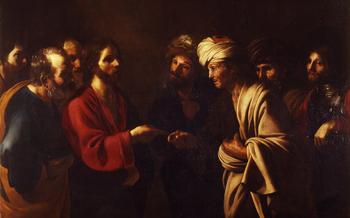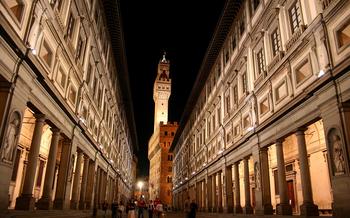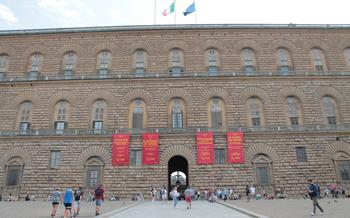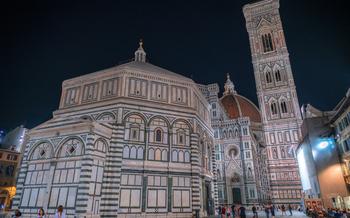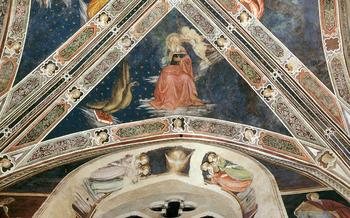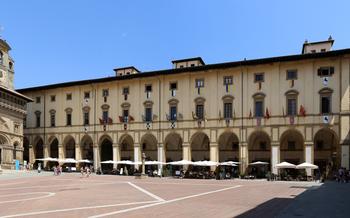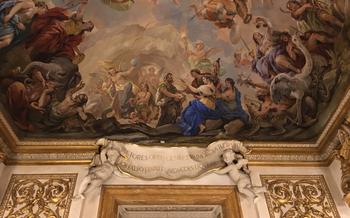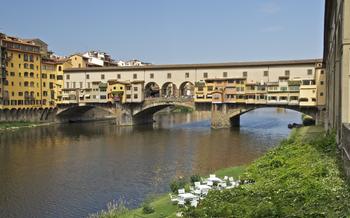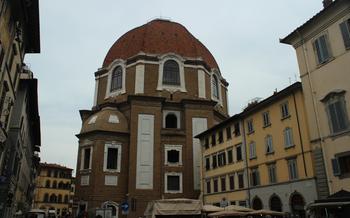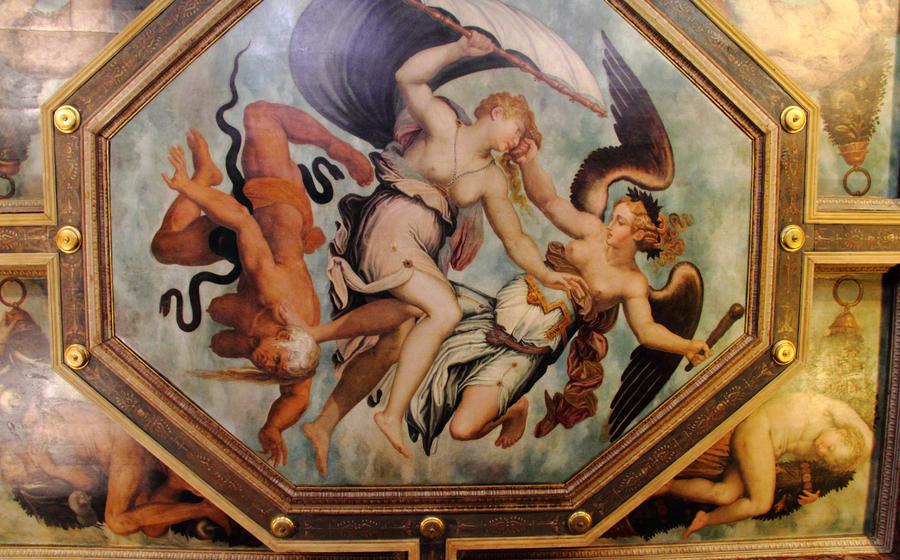
Casa Vasari
- Introduction - Arezzo and Its Fascinating History
- Casa Vasari - A Masterpiece of Renaissance Architecture
- Exploring the Casa Vasari
- Vasari's Life and Work
- Discovering Vasari's Frescoes
- The Vasari Corridor - A Hidden Gem
- Casa Vasari Museum
- Vasari's Studiolo - A Private Retreat
- Influence on Florentine Art
- Vasari's Legacy: A Lasting Impression on Art History
- Practical Information: Planning Your Visit to Casa Vasari
- Events and Exhibitions
- Accommodation and Dining
- Transportation:
- A Hidden Gem in the Heart of Arezzo: Unveiling Casa Vasari's Secrets
Introduction - Arezzo and Its Fascinating History
Arezzo, a captivating city nestled amidst the picturesque hills of Tuscany, holds a special place in the annals of Italian art and history. During the Renaissance, Arezzo flourished as a thriving center of artistic and cultural innovation, producing legendary artists such as Giorgio Vasari and Piero della Francesca. The city's rich artistic heritage is evident in its architectural wonders, where medieval charm harmoniously blends with Renaissance elegance. Among these architectural gems, the Casa Vasari stands as a testament to the city's illustrious past, inviting visitors to embark on a journey through time and immerse themselves in the fascinating world of Renaissance art and history.
Casa Vasari - A Masterpiece of Renaissance Architecture
Casa Vasari, a splendid manifestation of Renaissance design, stands as a testament to the genius of Giorgio Vasari, a renowned artist and architect of the period. Commissioned by Vasari himself, this architectural marvel epitomizes the essence of Renaissance ideals with its elegant frescoes and intricate architectural details.
Step inside Casa Vasari and be transported back in time to the heart of the Italian Renaissance. The residence exudes an aura of grandeur and artistry, showcasing Vasari's exceptional talent and his unwavering commitment to his craft. Admire the meticulously crafted frescoes that adorn the walls and ceilings, each brushstroke a testament to Vasari's mastery over color and composition.
Explore the building's architectural elements, from the graceful arches and columns to the delicate stucco decorations. Each detail has been carefully designed to create a harmonious ensemble, reflecting the principles of symmetry and proportion that were fundamental to Renaissance aesthetics. Casa Vasari is not merely a structure but a masterpiece, a living testament to the artistic brilliance of one of the most influential figures of the Renaissance era.
Exploring the Casa Vasari
Step inside the well-preserved Casa Vasari, a treasure trove of Renaissance art and architecture. Immerse yourself in its rich history as you wander through its elegant rooms, each adorned with stunning frescoes and intricate stucco decorations. Admire the vibrant colors, delicate brushstrokes, and captivating narratives depicted on the walls and ceilings. From scenes of mythology and allegory to portraits of famous figures, Vasari's frescoes are a testament to his exceptional skill and artistry.
Marvel at the intricate stucco decorations that embellish the walls and ceilings, adding depth and texture to the already opulent spaces. Intricate moldings, cherubs, and other decorative elements create a harmonious balance between the architectural features and the painted surfaces.
Casa Vasari is a visual feast for art enthusiasts and history buffs alike. It offers a unique opportunity to step back in time and experience the grandeur of the Renaissance firsthand. As you wander through its rooms, let your imagination soar as you immerse yourself in the world of Giorgio Vasari, one of the most influential figures in the history of art.
Vasari's Life and Work
Giorgio Vasari, the mastermind behind Casa Vasari, was a true Renaissance man. Born in Arezzo in 1511, he displayed exceptional talent in painting, architecture, and writing from a young age. Vasari's artistic journey took him to Florence, where he honed his skills under the guidance of renowned masters like Michelangelo and Andrea del Sarto.
Throughout his career, Vasari's genius manifested in various artistic endeavors. His frescoes adorned the walls of some of Italy's most prestigious buildings, including the Palazzo Vecchio and the Uffizi Gallery in Florence. As an architect, he designed several significant structures, including the Uffizi itself and the Vasari Corridor, an elevated passageway connecting the Uffizi to the Palazzo Pitti.
Vasari's legacy extends beyond his artistic creations. He is also remembered for his seminal work, "Lives of the Most Excellent Painters, Sculptors, and Architects," published in 1550. This groundbreaking book documented the lives and achievements of many Renaissance artists, offering valuable insights into the artistic landscape of the period.
Vasari's contributions to art, architecture, and art history solidified his status as a pivotal figure in the Renaissance. His versatility, artistic prowess, and intellectual curiosity epitomized the spirit of this transformative era.
Discovering Vasari's Frescoes
Casa Vasari is a testament to Giorgio Vasari's exceptional skill as a fresco painter. Step inside and be captivated by the vibrant colors, intricate details, and captivating narrative scenes that adorn the walls and ceilings. Vasari's frescoes are a visual feast for art enthusiasts and history buffs alike.
Each fresco tells a story, drawing inspiration from mythology, history, and Vasari's own imagination. From the epic battles depicted in the "Sala delle Battaglie" to the intimate portraits of the Medici family in the "Sala di Leone X," Vasari's frescoes offer a glimpse into the lives, loves, and passions of Renaissance Italy.
Take time to study the techniques and inspirations behind Vasari's frescoes. His mastery of perspective, use of light and shadow, and ability to capture the human form are evident in every brushstroke. Vasari's frescoes are not only visually stunning but also offer a profound insight into the artistic and intellectual currents of the Renaissance.
Casa Vasari is a unique opportunity to study Vasari's artistic style firsthand. As you admire these remarkable frescoes, you will gain a deeper appreciation for the genius of this Renaissance master and his lasting impact on the history of art.
The Vasari Corridor - A Hidden Gem
Casa Vasari holds a secret passageway known as the Vasari Corridor, an extraordinary architectural feat commissioned by the Medici family. Originally conceived as a private route connecting Palazzo Vecchio with Palazzo Pitti, the Vasari Corridor allowed the Medici family to move between their residences without venturing into the bustling city streets.
This elevated passageway offers breathtaking views of the city, allowing visitors to admire the picturesque landscapes and historical landmarks from a unique perspective. While traversing the corridor, one can marvel at the collection of self-portraits by renowned artists, providing a glimpse into the artistic community of the Renaissance.
Casa Vasari Museum
Immerse yourself in the life and works of Giorgio Vasari at the Casa Vasari Museum, housed within the walls of the historic residence. This museum is a treasure trove of art and history, showcasing Vasari's personal belongings, sketches, and other artifacts that provide a unique glimpse into his creative process and artistic influences.
Discover Vasari's personal studio, where he created some of his most renowned works, and explore the fascinating collection of his drawings, paintings, and sculptures. Learn about his collaborations with other great artists of the Renaissance, such as Michelangelo and Raphael, and gain insights into the artistic and intellectual climate of the period.
The museum also features a collection of Vasari's writings, including his famous book, "Lives of the Most Excellent Painters, Sculptors, and Architects." This seminal work, which provided biographies of many of the most important artists of the Renaissance, is considered a foundational text in the history of art and a testament to Vasari's role as a scholar and chronicler of the artistic world of his time.
Vasari's Studiolo - A Private Retreat
Deep within Casa Vasari lies a hidden gem, a private sanctuary known as the studiolo. This intimate space, tucked away from the bustling corridors of the residence, served as Vasari's personal refuge for contemplation, artistic inspiration, and creative work. The walls of the studiolo are adorned with exquisite frescoes, each a masterpiece in its own right. These vibrant paintings, executed with meticulous detail and rich symbolism, depict allegorical scenes, mythological figures, and personal reflections of the artist.
The ceiling of the studiolo is a celestial wonder, featuring a celestial map depicting the constellations and planets known during Vasari's time. The walls are adorned with scenes from classical mythology, such as the Judgment of Paris and the Labors of Hercules, as well as allegorical representations of the Arts and Sciences. Each fresco is a testament to Vasari's mastery of perspective, color, and narrative storytelling.
The studiolo was more than a workspace for Vasari; it was a reflection of his inner world, a place where he could retreat from the demands of his public life and immerse himself in the realm of creativity. Visitors to Casa Vasari are granted a rare glimpse into this private retreat, offering a unique opportunity to understand the artist's creative process and personal passions.
Influence on Florentine Art
Vasari's contributions to art and architecture extended beyond Arezzo, leaving a profound impact on the development of the Florentine Renaissance. As a leading artist and architect, he played a pivotal role in shaping the artistic landscape of Florence. His innovative ideas and techniques influenced a generation of artists, architects, and art patrons.
Vasari's architectural projects in Florence, such as the Uffizi Gallery and the Vasari Corridor, showcased his mastery of Renaissance design principles. His use of symmetry, proportion, and classical motifs set new standards for architectural excellence. His innovative use of the corridor as a means of connecting the Uffizi to the Palazzo Vecchio allowed the Medici family to move freely between their residences and government offices without having to venture outside.
In addition to his architectural achievements, Vasari's artistic style had a significant influence on Florentine painting. His vibrant colors, intricate details, and narrative scenes captured the essence of the Renaissance spirit. His ability to combine realism with allegory and symbolism made his works highly sought after by patrons and collectors.
Vasari's influence can be seen in the works of many of his contemporaries and followers, including Federico Zuccari, Jacopo Zucchi, and Giovanni Stradano. His emphasis on naturalism and emotional expression paved the way for the Baroque style that would dominate Italian art in the 17th century.
Vasari's legacy in Florentine art is undeniable. His innovative approach to art and architecture helped shape the unique character of the city. His contributions continue to inspire and influence artists and art enthusiasts worldwide.
Vasari's Legacy: A Lasting Impression on Art History
Giorgio Vasari's influence extended far beyond his time and continues to resonate in the world of art history. His writings, particularly the acclaimed "Lives of the Most Excellent Painters, Sculptors, and Architects," serve as a foundational text for understanding the Renaissance period and its artistic achievements. Vasari's detailed biographies of notable artists, including Michelangelo, Raphael, and Leonardo da Vinci, provide invaluable insights into their lives, techniques, and creative processes.
As an artist, Vasari's impact on Florentine art is undeniable. His distinctive style, characterized by vibrant colors, intricate details, and a mastery of perspective, influenced a generation of artists. His architectural contributions, such as the Uffizi Gallery in Florence, are testaments to his versatility and innovative spirit.
Vasari's legacy as a chronicler and historian of art is equally significant. His writings not only documented the lives of great artists but also shaped the way we perceive and interpret Renaissance art. His emphasis on individual genius and artistic development laid the foundation for modern art history.
To this day, Vasari's contributions continue to inspire and inform artists, historians, and art enthusiasts worldwide. His Casa Vasari in Arezzo stands as a living testament to his enduring legacy, inviting visitors to immerse themselves in the world of this Renaissance master and appreciate his lasting impact on the history of art.
Practical Information: Planning Your Visit to Casa Vasari
Before embarking on your journey to Casa Vasari, here's some essential information to ensure a smooth and enjoyable visit:
-
Address and Contact Details: Casa Vasari is conveniently located in the heart of Arezzo's historic center at Via XX Settembre, 5For inquiries, you can contact the museum via email at [email protected] or by phone at (+39) 0575 2392
-
Admission Fees: To enter Casa Vasari, there's a modest admission fee. Regular tickets cost €10, while reduced tickets for students and seniors are available at €Family tickets for two adults and two children are also offered at €2
-
Operating Hours: Casa Vasari is open to the public from Tuesday to Sunday, with varying hours depending on the season. During the summer months (April to October), it's open from 9:30am to 7:30pm, while in the winter months (November to March), it's open from 9:30am to 5:30pm.
-
Guided Tours: To fully immerse yourself in the history and significance of Casa Vasari, guided tours are available in various languages. These tours provide in-depth insights into Vasari's life, work, and the architectural marvels of his home.
-
Photography: To capture the beauty of Casa Vasari's frescoes and interiors, photography is permitted inside the museum. However, the use of flash and tripods is not allowed to preserve the integrity of the artworks.
Events and Exhibitions
Casa Vasari frequently hosts a variety of events and exhibitions that offer visitors a deeper dive into the world of art and history. These events provide an opportunity to engage with experts, participate in workshops, and discover new perspectives on Vasari and his work.
Check the official website of Casa Vasari or local tourism boards for up-to-date information on upcoming events. Some popular events include:
-
Vasari's Studiolo Revealed: A guided tour that delves into the symbolism and hidden meanings behind the frescoes in Vasari's private studio.
-
Renaissance Masterclass: A workshop where participants can learn the techniques of fresco painting under the guidance of experienced artists.
-
Art History Symposium: An annual gathering of scholars and enthusiasts to discuss the latest research and insights into Vasari's life and work.
These events offer a unique opportunity to learn from experts, connect with fellow art enthusiasts, and gain a deeper understanding of Vasari and the Renaissance era.
Accommodation and Dining
When planning your trip to Arezzo to visit Casa Vasari, you'll want to ensure you have comfortable and memorable accommodation and dining experiences. Here are some recommendations to enhance your stay:
Accommodation:
-
Hotel Continentale: A charming 4-star hotel situated within walking distance of Casa Vasari. It offers elegant rooms, a rooftop terrace, and a delightful breakfast spread.
-
Hotel Minerva: A welcoming 3-star hotel with a convenient location near the train station. It provides cozy rooms, a cozy lounge, and a complimentary breakfast.
-
Villa La Ripa: For a unique stay, consider this beautiful villa nestled in the Tuscan countryside just outside Arezzo. It offers stunning views, spacious rooms, and a swimming pool.
Dining:
-
Osteria delle Sorgenti: Indulge in traditional Tuscan cuisine at this cozy restaurant near Casa Vasari. Their homemade pasta dishes, grilled meats, and local wines are highly recommended.
-
Il Cantuccio: Experience fine dining in an elegant setting at this restaurant just steps from Casa Vasari. Their creative takes on Tuscan classics and extensive wine list will impress any food enthusiast.
-
Trattoria Da Sergio: For a casual and authentic dining experience, head to this family-run trattoria. Their hearty soups, wood-fired pizzas, and fresh seafood are local favorites.
These accommodation and dining options offer a taste of Arezzo's hospitality and culinary delights. Be sure to savor the local specialties like "bistecca alla fiorentina" (Florentine steak), "pici all'aglione" (thick pasta with garlic sauce), and "crostini neri" (black truffle bruschetta). Buon appetito!
Transportation:
Arezzo is well-connected to other cities in Italy by road and rail. If you are traveling by car, take the A1 motorway and exit at Arezzo. Follow the signs for the city center, and you will find Casa Vasari in Piazza Vasari. If you prefer to travel by train, take a train to the Arezzo railway station, which is a short walk from Casa Vasari. You can also reach Arezzo by bus from Florence, Siena, and other nearby cities.
Once in Arezzo, getting around is relatively easy. The city is compact and walkable, and Casa Vasari is located in the heart of the historic center. However, if you prefer to use public transportation, there are several bus lines that stop near the museum.
If you have time, consider taking a day trip to some of the other nearby attractions in Tuscany. Cortona, Montepulciano, and Pienza are all within a short driving distance of Arezzo and offer their own unique charm and history.
A Hidden Gem in the Heart of Arezzo: Unveiling Casa Vasari's Secrets
Beyond the well-known attractions of Casa Vasari, there lies a hidden gem waiting to be discovered. Tucked away on the upper floor, visitors can stumble upon a secret room known as the "guardaroba," or wardrobe. This intimate space, once used for storing precious garments and belongings, has been transformed into a captivating display of Vasari's personal collection. Here, visitors can admire a treasure trove of artifacts, including sketches, letters, and personal items that shed light on the artist's life and creative process. It's a rare opportunity to glimpse into the private world of a Renaissance master, offering a deeper understanding of his artistic genius and the world in which he lived.
